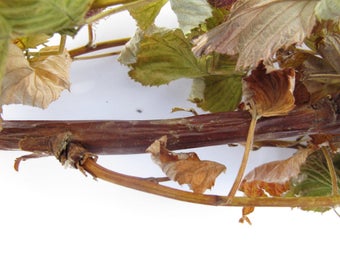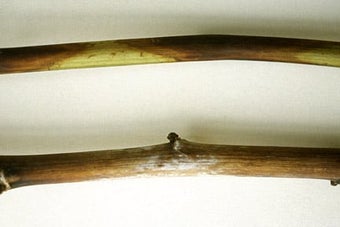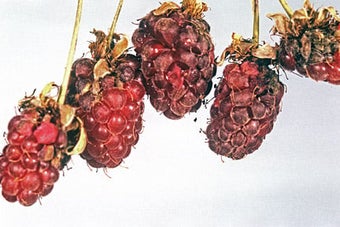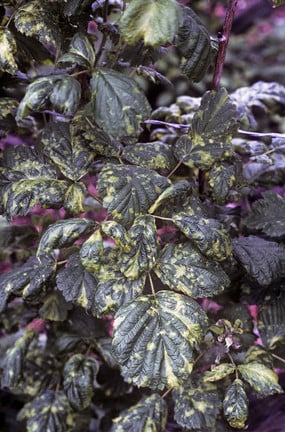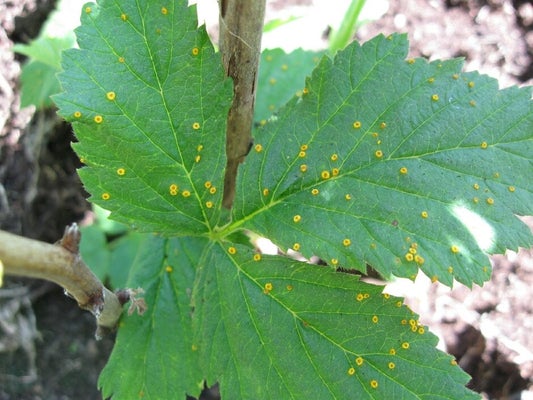
Quick facts
Common name - Raspberry rust
Scientific name - Phragmidium rubi-idaei
Plants affected - Raspberry
Main symptoms - Yellow pustules on the upper leaf surface in spring/early summer. Orange pustules on the lower surface as summer progresses. Black pustules on the lower surface in late summer/autumn
Caused by - Fungus
Timing - Throughout the growing period
What is raspberry rust?
Raspberry rust (sometimes called raspberry yellow rust) is a disease of the foliage of raspberries, caused by the fungus Phragmidium rubi-idaei. The fungus produces a number of different types of spore depending on the time of year and, as these different spores are produced, so the appearance of the disease changes. The microscopic spores are produced in structures called pustules. Leaf wetness is needed for infection, so attacks are worst during prolonged wet weather.
Symptoms
You may see the following symptoms:
- In spring and early summer: clusters of slightly raised, yellow pustules appear on the upper leaf surface, usually beginning on the bottom leaves
- As summer progresses: the pustules described above become less conspicuous, but numerous tiny orange pustules begin to be produced on the lower leaf surface, often with small yellow spots on the corresponding upper surface
- Large numbers (scores, or even hundreds) of these ‘summer spore’ pustules may be present on a single leaf
- Severe infection may lead to premature shedding of leaves
- In late summer and autumn: the orange pustules are gradually replaced by black ones, containing overwintering spores

Control
Non-chemical control
- If the yellow pustules can be spotted in spring, and just a few leaves are affected, then picking these off may slow the spread of the disease
- If large numbers of leaves are affected, however, removing them will do more harm than good
- Collect up and dispose of any leaves that fall prematurely, together with the rest of the leaves as they fall in the autumn
- Ensure that the canes are not too crowded as this will lead to poor air circulation, prolonged leaf wetness, and higher disease levels
- Feed plants adequately to ensure good vigour, but don’t overdo it as this will produce excessively soft growth that is more prone to attack
- Raspberry cultivars differ somewhat in their susceptibility to rust – 'Glen Ample', 'Glen Clova', 'Glen Lyon', 'Glen Moy' and 'Tulameen' are commonly affected, but 'Glen Prosen', 'Julia' (not readily available) and 'Malling Admiral' show some resistance. At RHS Wisley, 'Octavia' has remained relatively rust-free when some nearby cultivars have been heavily infected
Chemical control
No fungicides are available to home gardeners for the control of raspberry rust.
Biology
The rust fungi are described as biotrophs; that is, they grow within the living tissues of the plant and extract from the cells. Although they do not kill tissues rapidly, heavy attacks by rusts can cause leaves to fall prematurely, which is the case with raspberry rust.
It is the spores produced in the orange pustules on the underside of the leaves that are mainly responsible for spreading the disease from leaf to leaf and plant to plant during the summer. Those produced in the black pustules in late summer are overwintering spores which, as well as surviving on the fallen leaves, can also become attached to the stems and to posts, wires, etc.
Infection is favoured by wet or humid conditions. The disease is therefore most problematic during wet summers and where air circulation through the canes is poor.
Unlike some other rust fungi the life cycle for raspberry rust does not involve an alternate host.


